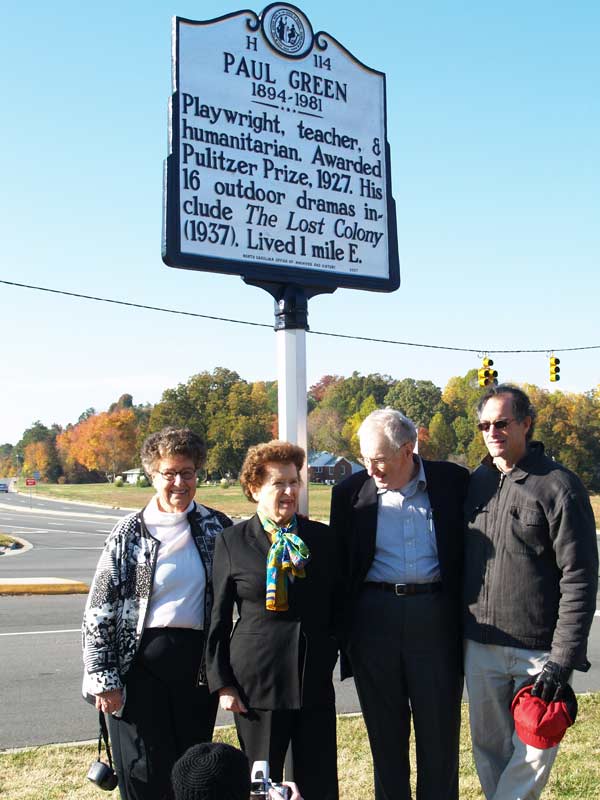
Three of Paul Green’s children, Byrd Green Cornwell, Betsy Green Moyer, Paul Green Jr., and his grandson, Paul Green III get their picture taken at the unveiling of the Paul Green historic marker just south of town on U.S. 15-501.Â
By Valarie Schwartz
PAUL GREEN
1894-1981Playwright, teacher, &
humanitarian. Awarded
Pulitzer Prize, 1927. His
16 outdoor dramas in-
clude The Lost Colony
(1937). Lived 1 mile E.
Not too many years ago, the sign erected last week with the above words would have stood in the front yard of an old farmhouse.
Today, it lends stability at the corner of US 15-501 and Old Lystra Road, next to the UNC Park & Ride that opened there earlier this year, in a stretch of road where change has been continual over the past decade.
The sign is one of 1,500 historical markers in the state and the 16th in Chatham County. That spot was chosen because Paul Green lived and died a mile away at the home he called Windy Oaks on 221 acres he bought in 1961. Green lived there with his wife, Elizabeth, until his death in 1981.
A dozen or so people attended the unveiling of the sign bright and early Saturday morning, including three of the four Green children, Paul Green Jr., who recently moved back to Chapel Hill, Byrd Green Cornwell of Valdese and Betsy Green Moyer of Wayland, Mass. Paul Green III of Durham also attended, along with a number of members of the Paul Green Foundation board and its executive director, Alexandra Lightfoot.
It’s good to be reminded of Paul Green and to learn from his offspring what they remember about their father — that he was fearless. Of course they may not have realized it as children, because back when he started talking about inequality and discrimination his was a lone voice — one so out of the blue that it sometimes brought a stunning silence.
A few months ago, Moyer shared in an email a story from 1937. It was at the opening ceremony of “The Lost Colony,†a play he wrote, which continues to be performed every summer on Roanoke Island.
“He came to the podium, looked out at the segregated audience and at the rope that divided them,†Moyer wrote. “He stood silent for a long time, for such a long time the audience became restive. Finally he spoke and said (something like this), ‘I live for the day when the rope that divides you has been torn down and we sit side by side, black next to white and white next to black.’ It was a courageous statement to make at a time in our history when there were few whose vision and words reflected such honesty and clarity.â€
Imagine a tall, lanky white man from Harnett County with the foresight 70 years ago to hope for — much less speak publicly of — a society without color lines.
“He was not only outspoken, he also was proactive,†Moyer said. “He was never quiet when he witnessed a discriminatory act, whether the act was against African-Americans, teachers accused of communist leanings†or any of the causes he championed and wrote about, like capital punishment, chain gangs, lynching and war.
There’s a new sign among us. Perhaps those who pass it will seek information about the man it honors and it will awaken the humanitarian credo of Paul Green within them.
Contact Valarie Schwartz at 923-3746 or valariekays@mac.com .
